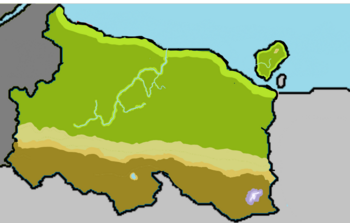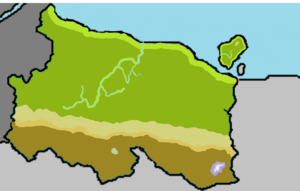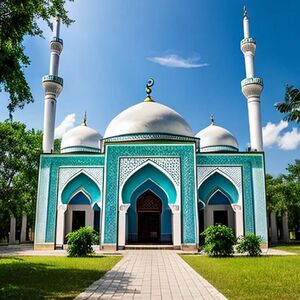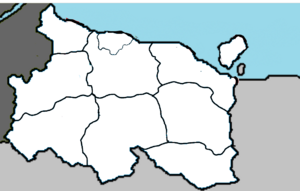Bentho
Secular Republic of Bentho República Secular de Bentho | |
|---|---|
|
Flag | |
| Motto: "Bentho, Com Todos Os Caminhos e Tempo" | |
| Anthem: Armonía del Corazón Benthense | |
 Map of Bentho | |
 | |
| Capital and City | San Pera |
| Official languages | Benthese, Spanish |
| Ethnic groups | Sarkosian |
| Government | |
• Presdient | Juan Carlos Caballero |
| Population | |
• 2020 estimate | 11,321,987 |
| GDP (PPP) | 2022 Estimate estimate |
• Total | 335.7 Billion |
• Per capita | 30,454.55 |
| Gini | 0.12 low |
| HDI | .897 very high |
| Date format | MM-DD-YY |
| Driving side | right |
Bentho officially known as the Secular Republic of Bentho, is a sovereign nation located in northeast Ausiana, in the region of Carubana. It is bordered to the west by Vulkaria, to the south by Cirrane, and to the east by (no one lol), with a northern coastline along the Sea of Vulkaria in the North Samson Ocean. Due to its location, Bentho relies on the Vulkarian Pass to trade with countries in Western Euronia.
Bentho was founded in 1604 after the result of the Crimson Sun War, the war unfolded as a momentous conflict during the 16th century, dividing the land into two distinct countries. In the north, the prosperous Kingdom of Valeridia flourished under the rule of King Rodrigo Solario. The Valeridian forces, known as the Solarin Guard, fought fiercely to preserve their kingdom's unity and honor. In the south, the rugged land of Sombreria was home to the formidable Peñalay Coalition, led by General Esteban Fuegoluz. The Peñalay Coalition, comprised of skilled guerilla fighters and rebellious clans, resisted Valeridian influence and fought for their autonomy and freedom. For 11 tumultuous years, the Crimson Sun War raged on, with epic battles and strategic maneuvers defining the conflict. In February of 1604, the Kingdom of Valeridia emerged as the victor, unifying the realm under King Rodrigo's rule, The Battle of Hohebar, which was the Peñalay capitol, were the Valeridian forces stormed the city, the city fell in a few hours, which was the end of the war, the results is were Valeridia annexed Peñalay uniting Bentho.
Bentho is a member of the Coalition of Crown Albatross.
Etymology
The name "Bentho" is believed to have originated from ancient legends and folklore, passed down through generations in the region. According to one popular tale, Bentho derives its name from an ancient deity known as Benthos, a revered guardian spirit believed to watch over the land and its people. The name was bestowed upon the region as a tribute to the deity's protective presence and the profound connection the inhabitants felt with the land, In another interpretation, the name "Bentho" is thought to have roots in the ancient language of the early settlers. It is said to derive from a combination of words that roughly translate to "blessed land" or "land of abundance." This reflects the fertile landscapes, bountiful natural resources, and the sense of prosperity that characterized the region, Over time, the name "Bentho" became ingrained in the identity and history of the region, symbolizing its unique cultural heritage and the strong bond between the land and its people. Today, the name "Bentho" carries with it a sense of pride and reverence, serving as a reminder of the ancient origins and enduring legacy of this vibrant and diverse region.
History
Pre-Historic
The Empire of Valerius was a thriving ancient civilization in Bentho from around 2000 to 930 BCE. It encompassed vast territories, experienced territorial expansion, economic prosperity, and cultural flourishing. The Valerian emperors implemented strong governance and promoted unity among their subjects. Valerion, the capital city, became a center of commerce, culture, and intellectual pursuits. However, internal conflicts, external pressures, and the challenges of maintaining a large empire led to its downfall around 930 BCE.
In the aftermath, Queen Celestria emerged as a charismatic leader and established the Queendom of Celestria. The queendom brought stability, unity, and female leadership to Bentho. Queen Celestria focused on rebuilding, unifying territories, and empowering her subjects. The fall of the Empire of Valerius and the rise of the Queendom of Celestria marked a transformative period in Bentho's history, highlighting resilience and the potential for renewal in the face of adversity.
13th Century
UNDER REVISION
20th Century
The Bentheese economy began to grow with its most important sectors being in lumber, farming, and fishing, and the introduction of the Vulkarian Pass placed Bentho right on the precipice of a new vital and heavily used international shipping lane, which contributed greatly to a boom in its economy. A severe drought in 1929 led to the Bentho Depression, which not only affected the agricultural and freshwater fishing industries, but led to the deaths of tens of thousands of people. A religious reconciliation occured as a result of the depression, which was a major contributing factor in Bentho's relative secularism to this day.
World War
Bentho's government attempted to stay neutral at the outbreak of the World War in 1949, during which time the DSC and Rumaztria had invaded and conquered much of neighboring Vulkaria in order to seize vital port cities and the Vulkarian Pass. Bentho's economy, reliant on international shipping passing through the canal, took a major hit as shipping ceased and neighboring countries joined the League Powers. Bentho's government signed multiple non-hostility treaties with the DSC and Teresta to avoid being drawn into the conflict, but the government was covertly supplying weapons and food to Vulkarian resistance fighters. Bentho successfully remained out of direct conflict for around 8 months, instead becoming a haven for many refugees fleeing fighting in northeastern Ausiana.
Sometime in September 1951, a telegram directed from Bentho to resistance fighters in Vulkaria was intercepted by League Forces in Tilbreg, detailing the covert supply missions. As a result, on October 19th, 1951, Teresta and Gashuera broke their non-aggression treaties with Bentho and invaded through occupied Jericho and Cirrane. Bentho's military, small in comparison to the well-equipped and experienced league forces, was decimated in the invasion, and the country's major population centers were quickly overrun. However, many rebel groups sprung up within Bentho to resist the occupation, with vice-president Francisco Cruz Madruga in particular leading several factions. For two years, brutal urban and rural fighting engulfed Bentho as a sizable portion of the population took up arms against Terestan and Gashueran forces. The Battle of Quipata in early 1953 saw the first instance of Bentho's resistance groups freeing one of their major cities from occupying armies.
By December of 1952, the DSC had been pushed out of the northern half of Vulkaria by Allied forces, and Ruzmatrian forces were in retreat on the southern front. In July 1953, allied forces consisting of Emmirian, Albarinean, and Cadairi troops entered Bentho from the freed areas of Vulkaria and began pushing back Terestan forces. They were joined by the Bentho resistance groups, who were vital in the success of allied forces. Gashuera capitulated on August 6th, 1953, leaving Teresta a weakened and vulnerable military. By August 8th, the capital of San Pera was freed, and on August 19th the last Terestan forces retreated over the border into Jericho. Following the liberation of Bentho, Marcos Amorim Esteves sent two brigades of men to participate in the Eastern Front of the war in Euronia, where they assisted in the liberation of Avergnon.
Geography
Bentho's captivating geography serves as the foundation for its rich cultural tapestry and storied history. The country is blessed with diverse regions, each contributing unique elements to the nation's identity and way of life.
The Sarkos, occupying the northern half of Bentho, embraces a tropical climate with abundant rainfall and a warm, welcoming atmosphere. This region has nurtured the growth of major cities like Caapulas, whose vibrant urban centers pulsate with life and cultural vibrancy. The Sarkos is a land of fertile soils and lush vegetation, creating an ideal environment for agriculture and biodiversity to thrive. The government's proactive approach to conservation has safeguarded vast stretches of the Sarkos in the form of nature reserves and national parks. These protected areas are not only essential for preserving Bentho's incredible variety of flora and fauna but also vital to the country's flourishing ecotourism industry, which attracts nature enthusiasts and adventurers from all corners of the globe. Within the Sarkos, hidden amidst its emerald landscapes, resides the treasured Benthenses Capybara, the national animal and an emblem of the country's natural splendor.
Venturing southward, one encounters the awe-inspiring Cordillera del Illimani, a mountainous wonderland that captures the imagination with its rugged beauty. This region's climate is a tapestry of contrasts, with the influence of the Ausianan steppes to the south and the warm tropical ocean currents to the north resulting in a unique rain shadow effect over much of Cirrane. The Cordillera experiences distinct rainy and dry seasons, each adding its rhythm to the ebb and flow of life in this rugged realm. Here, the majestic Mount Alonso stands tall, its soaring height of 9,762 feet (2,975 meters) making it an iconic symbol of Bentho's natural grandeur and a source of pride for its people.
Beyond the Sarkos and Cordillera del Illimani, Bentho's geography is also adorned with other natural gems. The Northern reaches boast pristine coastal stretches, where the warm embrace of the tropical ocean is met with stunning sandy shores. These coastal areas have nurtured thriving fishing communities, enriching Bentho's cuisine with a delectable array of seafood delicacies. The eastern parts of the country are adorned with rolling plains and savannas, providing ideal conditions for ranching and agriculture, further diversifying the country's economic and cultural landscape.
Throughout history, Bentho's geography has been instrumental in shaping the nation's identity, with various regions influencing the development of unique cultural traditions, art, and customs. The Sarkos' fertile lands and tropical climate have fostered a love for music, dance, and vibrant celebrations, while the rugged landscapes of the Cordillera have instilled a deep appreciation for resilience and determination in the face of challenges.
Vegetation and Fauna
Vegetation
Bentho's diverse and captivating landscape is adorned with a rich variety of vegetation, reflecting the country's unique climate and geography. While vegetation can be found throughout the nation, it thrives most abundantly in the Sarkos, a region celebrated for its lush forests and fertile soils.
The Sarkos is a verdant paradise, boasting a plethora of plant species that contribute to the country's rich biodiversity. Among the most common trees in this region is the majestic Kapok tree, known for its towering height and impressive buttress roots. The Kapok tree serves as a keystone species, providing a vital habitat for various animals and insects. Its cotton-like seeds are dispersed by the wind, aiding in the natural regeneration of the forest. This majestic tree stands as an emblem of life and renewal, playing a significant role in the Sarkos' ecosystem.
In second place among the Sarkos' prominent vegetation is the Mangifera indica, a tree that produces succulent mangoes. This tree flourishes across the entire Sarkos region, gracing both its interior forests and the picturesque coastal areas of Bentho. The abundance of the Mangifera indica adds a delightful burst of flavor to the nation's cuisine, with ripe mangoes being a popular tropical treat enjoyed by locals and visitors alike.
The Sarkos' diverse vegetation owes much to the unique climate of the region. The presence of the Ausianan steppes to the south creates a rain shadow effect, making it challenging for rain clouds to pass over the mountains. As a result, much of the precipitation is confined to the Sarkos, nourishing the land and sustaining the vibrant array of plant life. The plentiful rainfall contributes to the region's vibrant forests and fertile soils, providing an ideal environment for plant growth and creating a haven for wildlife.
Fauna
Bentho, a country teeming with diverse ecosystems, is home to an array of fascinating animals that add to the richness of its natural heritage. One of the most beloved and iconic creatures in Bentho is the Benthenses Capybara, proudly serving as the national animal. With a population of approximately 500,000 capybaras in the country, these friendly and sociable rodents are often spotted in the lush greenery along riverbanks and wetlands.
While Bentho's wildlife offers enchanting encounters, it also houses formidable predators, with the jaguar reigning as the most dangerous animal in the country. With around 25,000 jaguars dwelling within Bentho's vast landscapes, these majestic big cats command both awe and respect. Their presence serves as a reminder of the delicate balance that exists between predator and prey in the country's natural habitats.
In addition to the capybara and jaguar, Bentho showcases a plethora of tropical treasures. The Orangutan, renowned for its intelligence and gentle demeanor, finds sanctuary in Bentho's verdant rainforests. The Hornbill, with its striking bill and vibrant plumage, adds a touch of exotic beauty to the country's skies. Meanwhile the Ausianan rhino, finds refuge in Bentho's protected areas, contributing to conservation efforts for these magnificent creatures.
One of the few venomous animals in Bentho is the King Cobra, whose striking presence is limited to the far southwest part of the country. This majestic serpent, feared for its potent venom, remains an important part of Bentho's biodiversity, inspiring both fascination and caution among locals and visitors alike. Adding to the tropical allure, the vibrant toucan, with its colorful beak and playful demeanor, graces Bentho's rainforests, becoming a symbol of the country's vibrant wildlife.
Demographics
Religion
Religion in Bentho has shifted over time. Prior to the World War, the prominent religion was Sanguine. The decline of religion in Bentho came largely as a result of the Bentho Depression in 1929 and the World War, both events which contributed to a major reevaluation of faiths in Bentheese society. In 2022, 78% of Bentho's population was non-religious.
The most followed religion in Bentho is Catholicism, with around 8% of the population (~905,000 people). Most catholic groups are located in the north of the country. The next largest religion is Shintoism, with 5% of Bentho's population practicing. Islam consists of around 3% of the population and is the fastest growing religion in Bentho. There are laws protecting Islam from hate-crimes, passed by presdient Mónica Ramos in 2003.
Bentho banned religious involvement in the government in the Bentho Constitution. As defined in article 7; "Any religion that has a way of overpowering the national or local government must be avoided at all costs, to protect it from biased behavior of his or her ways of life." However, someone who is religious can run for president or political office, though they can face being removed from office if it is deemed religion played a part in their policymaking.
Population
Bentho had a population around 11.3 million in 2022. The majority of the population is aged 24-29, contributing to Bentho having one of the youngest average populations in the world. It also has one of the highest literacy rates among its population, at 99% of people knowing how to read and write. However, Bentho has one of the slowest growing populations in the world, having not increased more than 30% since the end of the World War in 1954. Bentho's population is estimated to reach 18 million in 2050.
The majority of Bentho's population is native to Bentho, with 88% being native Bentheese, 2% Pongian, 5% Vulkarian. In 2022, the majority of foreign visitors or immigrants to Bentho spoke their native languages. The fertility rate in Bentho is 1.54 births per women. There is 993 males per 1,000 females in Bentho.
Cities
See article Cities in Bentho
|
Largest Census Metropolitan areas in Bentho by population | |||||
| No. | CMA City |
Population | |||
| 1 | San Pera | 1,247,103 | |||
| 2 | Quipata | 1,143,048 | |||
| 3 | Caapulas | 983,321 | |||
| 4 | Lazana | 865,134 | |||
| 5 | Tepiapo | 772,134 | |||
| 6 | Huabo | 713,064 | |||
Government
The Constitution of Bentho stands as the guiding document that mandates the government to abide by its principles and provisions. As the fundamental law of the land, the Constitution lays out the framework for governance, defining the rights and responsibilities of both the government and its citizens. It serves as the beacon of democracy, ensuring the protection of individual liberties, upholding the rule of law, and fostering a system of checks and balances. As the highest authority, the Constitution serves as a constant reminder of the government's obligation to adhere to its provisions, creating a stable and accountable governance structure that upholds the values cherished by the people of Bentho.
Legislature
List of List of current Bentho senators
In the heart of Bentho's capital, San Pera, the nation's governance thrives with a robust and well-structured system comprising three branches of government. Each branch plays a distinct role, ensuring a balanced and efficient decision-making process for the betterment of the country and its people.
The Bentho Senate stands tall as the upper legislature, comprising 100 seats distributed evenly among the states, with each state holding 10 seats. Established in 1604, the Senate has a long and storied history, symbolizing the country's commitment to democratic governance. This esteemed body wields considerable power, particularly in the realm of legislation. Senators meticulously debate and vote on bills and laws that shape the nation's policies and regulations, ultimately shaping the course of Bentho's development. The Senate also possesses the critical authority to impeach political officeholders, holding them accountable for any wrongdoing or violation of the law. To maintain the democratic fabric of Bentho, the Senate undergoes an election every year with each of the one of the two seats alternating elections ensuring a constant influx of fresh perspectives and ideas from the people.
On the other hand, the Bentho National Assembly takes the helm of international affairs, steering the nation through the intricate web of global relations. With an impressive 392 seats, the National Assembly exerts its influence on matters of utmost significance, such as voting on treaties, military interventions, and trade deals. This distinguished body recognizes the value of cooperation and diplomacy on the world stage and actively seeks to foster alliances that promote Bentho's interests and safeguard its sovereignty. The assembly's members diligently represent the diverse voices of the populace, working collectively to shape Bentho's position in the global arena. To maintain a stable and continuous trajectory, the National Assembly conducts elections every 6 years, granting ample time for its members to immerse themselves in the complexities of international affairs and craft strategic decisions that secure Bentho's prosperity.
List of political parties in Bentho
States
| Province | Postal abbrev. |
Capital | Population | Electoral Votes |
|---|---|---|---|---|
| District of San Pera | DSP | San Pera | 1,893,098 | 20 |
| Palno | PAL | Lazana | 2,019,102 | 27 |
| Caumao | CUA | Monsotivo | 903,216 | 16 |
| Chiquique | CHI | Huabo | 1,236,908 | 8 |
| Aregoyape | ARE | Caapulas | 1,391,043 | 11 |
| Jacardaes | JAC | Quipata | 1,776,210 | 11 |
| Florina | FLO | Jerica | 408,554 | 9 |
| Contacicaba | CON | Yebati | 676,210 | 6 |
| Barbagaba | BAR | Lamlota | 983,219 | 8 |
| Huamors | HUA | Tepiapó | 1,413,637 | 12 |
Foreign Relations
Bentho's diplomatic landscape paints a vibrant picture of interconnectedness with nations across the globe. The cosmopolitan city of San Pera serves as a hub for international relations, hosting consulates and embassies from various countries, each fostering robust ties with the Benthese government. Spearheading this intricate web of diplomatic relations is the Ministry of Foreign Affairs, a key institution that plays a pivotal role in managing and enhancing Bentho's global partnerships. Under the guidance of the government, the Ministry ensures the smooth functioning of diplomatic missions and endeavors to strengthen international cooperation on diverse fronts.
In the ever-evolving era of globalization, Bentho's bonds with nations in southwest Adula have notably intensified. These strong ties serve as a testament to the nation's commitment to fostering meaningful alliances and facilitating mutual growth and prosperity. Embracing constitutional democracy and individual liberties, Bentho confidently stands as a staunch advocate of democratic values on the global stage. Its international engagements reflect a profound respect for the principles of nonintervention, multilateralism, and the sanctity of national sovereignty. Furthermore, Bentho holds steadfast to the tenets of the rule of law, valuing diplomacy as the primary means of settling disputes and fostering understanding among nations.
Central to Bentho's international approach is its unwavering commitment to abide by its Constitution. The government holds a solemn duty to adhere to the principles and regulations enshrined in this foundational document. The Constitution serves as the bedrock of governance, guiding the nation's actions and policies both domestically and in its interactions with the international community. By upholding these constitutional values, Bentho reinforces its reputation as a responsible and respected global player, one that seeks to promote peace, cooperation, and prosperity on the world stage.
Bentho's most steadfast ally is the nation of Pongi, a relationship forged on the foundation of shared governmental systems, intertwined historical and cultural ties, and mutual responses to significant global events. The bond between Bentho and Pongi has grown to be an exemplar of diplomatic collaboration, marked by a strong sense of trust and cooperation.
Military
The Benthenses Armed Forces (BAF), the principal military force of Bentho, emerged in 1859 following a tumultuous period of political upheaval triggered by a failed government coup. With a staunch commitment to safeguarding the nation's sovereignty and ensuring the safety of its citizens, the BAF stands as a formidable institution, instilling a sense of security and stability in the country. Conscripting both men and women for a mandatory term of at least one year, the BAF ensures a robust and well-trained force capable of defending the nation from any potential threats.
The BAF's conscription laws allow for certain exemptions and adjustments based on individual circumstances, such as involvement in sports, disability, or illness. As an appreciation for the sacrifices made by its service members, the BAF goes the extra mile by providing financial support for the families of military personnel during their period of service. This gesture of care and acknowledgment underscores the government's commitment to its armed forces and their loved ones.
On the picturesque island of Huarmos, the Huarmos Island Forces (HIF) operates as an autonomous branch, working in tandem with the BAF to bolster security in the region. The HIF acts as a capable and strategic partner, adding to the overall strength and readiness of the nation's military. With approximately 250,000 active members and an impressive reserve of around 1,000,000 personnel, the BAF's sizeable force is a testament to the dedication of the Benthese people to their nation's defense.
Over the years, Bentho has skillfully maintained diplomatic relations with other nations, resulting in relatively few tense moments and a lack of threats to its sovereignty since the conclusion of the World War. Bentho's remote location has contributed to its peaceful existence, allowing the nation to focus on its internal development and fostering cooperative relationships with its neighbors. The BAF, with its three branches – the Bentho Army, Bentho Navy, and Bentho Air Force – remains ever-vigilant, prepared to respond to any potential challenges to Bentho's security.
The Bentho Navy, operating primarily as a green-water navy, focuses its efforts within the confines of the Sea of Vulkaria. The navy boasts a single aircraft carrier, the NAE San Pera, which serves as a symbol of the nation's commitment to maritime security and projection of power. Meanwhile, the Bentho Air Force undertakes the responsibility of conducting strategic and tactical aerospace operations, asserting the nation's sovereignty over its airspace. The air force's capabilities extend to both defensive and offensive measures, positioning Bentho as a formidable force in the realm of aerial operations.
Culture
Sports
Sports in Bentho are a major part of its national identity and culture. The most popular sports are soccer, rugby, and baseball, hockey is also on the rise
Bentho Primera División is the biggest soccer league in Bentho, with Bentho Leauge 2, Bentho Leauge 3 Bentho Leauge 4 being lower leauges. The Bentho national football team represents Bentho in international tournaments like the World Cup and the Olympics.
Rugby is the second-most popular sport in Bentho. The Caapulas Capybaras placing runners-up in the International Rugby League's 2023 championship, falling short to the Tarijibar Lions. The Bentho Rugbi Liga is the main league in Bentho with 24 teams the season begins in mid July and ends in mid March,
Baseball is the third most popular sport in Bentho. The Liga Bentho Beisebol has lots of culture, mostly in the north of Bentho where the Trichado Bucaneers have the most victories with 21.
Hockey in Bentho is the 4th most popular sport, and is growing even though Bentho is a tropical country Hockey has a strong suit in Bentho and a hockey league was made in 2010 with the Quipata Avalanche winning their division cup most of the time followed by winning the whole competition.
Art
Bentho's art scene is largely centered around painting. Benthos most famous painter, Iker Gutierrez, is well known for utilizing the natural landscapes of Bentho in his imagery, renowned often for choosing a seemingly random place in Bentho to paint. His most famous works include the O Meditação (the Meditation). Gutierrez, born in 1939, still produces art which he donates to the Arte do Bentho, the museum he frequented as a child.
Movies
Movies, or cinema, in Bentho have evolved into a significant cultural phenomenon, captivating audiences and contributing to the artistic landscape of the region. With a rich tradition of storytelling and a deep appreciation for the visual arts, Bentho's cinema industry has flourished, offering a diverse range of films that reflect the unique perspectives, narratives, and creative expressions of its people.
The development of Bentho's cinematic heritage can be traced back to the early days of silent films, where pioneers in the region experimented with the medium and crafted captivating stories using imagery and intertitles. As technology advanced, the introduction of synchronized sound and vibrant color brought new dimensions to the cinematic experience, captivating audiences with immersive storytelling and breathtaking visuals.
Bentho's film industry has seen the rise of visionary directors, talented actors, and skilled technicians who have pushed the boundaries of storytelling through their creativity and artistry. From thought-provoking dramas to lighthearted comedies, epic historical sagas to contemporary tales of love and identity, Bentho's cinema encompasses a wide range of genres and themes that resonate with local audiences while also appealing to international viewers.
Music
Music in Bentho is a vibrant and integral part of the country's cultural fabric. One of the most popular and distinctive music genres in Bentho is known as Ritmo" a fusion of tropical beats, lively rhythms, and indigenous musical influences. The genre's unique blend of lively melodies and infectious grooves reflects the nation's rich diversity and celebratory spirit.
Ritmo roots can be traced back to ancient Benthese traditions, where music played a significant role in religious ceremonies, storytelling, and community gatherings. Over the centuries, the genre has evolved, incorporating elements from various cultures that have left their mark on Bentho's history.
The use of traditional instruments, such as drums, flutes, and maracas, adds an authentic and distinctive touch to Ritmo. Modern music production techniques and contemporary instruments have also found their way into the genre, creating a dynamic and captivating musical experience.
Ritmo popularity extends far beyond Bentho's borders, drawing international acclaim for its infectious energy and captivating rhythms. Whether it's the lively beats of a Carnaval celebration or the soul-stirring melodies of a tropical sunset, Ritmo serves as a soundtrack to the vibrant spirit of Bentho, uniting people in joyous harmony and celebration.
Cuisine
Benthenses Cuisine is another important staple of the national culture. Depending on the area of the country, the food varies. The north of Bentho, with cities like San Pera, food tends to have more vegetables and flour. Wheat in Bentho is rare to find in culinary products, as rice, buckwheat, and tapioca is the main source of flour in Bentho. North Bentho Cuisine tends to have more products that are sweet and sour, thanks to its tropical climate. Bentho is the world's largest exporter of mangoes, and cooking with mangoes is quite common throughout the north of the country. In the southern mountainous regions, cuisine tends to be less diverse and less flavorful than the north.
Economy
Bentho's economy has a socialistic and capitalist aspect to it, private industry is allowed but to get a business it must be approved by the goverment first. The business that the owner creates is owned and ran by the person who made it, but the government is the overseer-er and if the business does violates the contract it agreed to, it will be seized and handed over to the government. The auron is worth around Z$1.19
Trade
Bentho is a nation known for its flourishing trade relationship with its largest partner, is --COUNTRY--. This cooperative bond has facilitated economic synergy and has been characterized by a history of collaboration. Notably, Bentho has not implemented any documented embargoes on other countries, nor has it faced significant trade embargoes from its trading partners.
One of the distinctive aspects of Bentho's economy is its thriving mango export industry. Bentho has become a global leader in mango production, captivating the taste buds of consumers worldwide with its delicious and high-quality mangoes. The export of this tropical fruit plays a pivotal role in Bentho's economic growth. The mango industry in Bentho contributes approximately $30.5 billion to the country's economy , making it a significant driver of economic prosperity. Moreover, this sector adds around $326.5 million to Bentho's economy each year, benefitting numerous livelihoods and supporting agricultural development in rural areas.
Transport
Bentho boasts a well-developed domestic transit system that includes an extensive network of trains and other public transportation options. Notably, the country's commitment to sustainable practices and environmental consciousness has led to the implementation of an impressive electric railroad that spans across the entire country. This electrified railway not only efficiently connects major cities and towns but also serves as a vital backbone for the nation's booming tourism industry. With its modern infrastructure and reliable services, the electric railroad provides both locals and visitors with a convenient and eco-friendly means of traversing the diverse landscapes of Bentho, allowing them to explore its picturesque vistas, historical landmarks, and vibrant cultural destinations with ease and comfort, ZephyrLine servers as a major cities in Bentho, reaching a speeds of 250 km/h (155 mph).
San Pera International Airport (SPA) proudly stands as the largest and busiest airport in the country of Bentho, serving as the primary gateway to this enchanting land. With its state-of-the-art facilities and modern infrastructure, SPA exemplifies efficiency and convenience for millions of travelers each year. As the main hub for Bentho Airways, the country's leading airline, SPA connects the nation to various domestic and international destinations, fostering economic growth and cultural exchange. The bustling airport, located in close proximity to the historic city of San Pera, offers a wide range of amenities, from luxurious lounges to vibrant shopping and dining options, ensuring that passengers have a pleasant and memorable experience while transitioning through this aviation hub. Bentho's aviation sector plays a pivotal role in supporting the country's thriving tourism industry, as visitors from across the globe embark on their journeys of exploration and discovery. Notably, Quipata International Airport (QPA) also stands as a major aviation facility in Bentho, complementing SPA's role in catering to the country's diverse air travel needs and contributing to the overall connectivity and accessibility of this captivating country. With a network of modern airports and efficient airlines, Bentho stands poised to welcome and accommodate travelers, fostering both national and international connections that enrich its vibrant cultural tapestry.
Energy
In the year 2020, Bentho, a small country with a commitment to sustainable energy, relied on various energy sources to power its infrastructure. The predominant energy source was hydroelectric power, accounting for a substantial 75.0% of the country's energy production. Additionally, solar energy contributed 15.5% to the overall energy mix, while wind power constituted 7.5%. Other renewable sources, such as geothermal and biomass, collectively provided 1.5% of the energy, showcasing Bentho's diversified approach towards sustainability. The remaining 0.5% comprised imported natural gas and oil, which were necessary to meet the country's energy demands.
Building on this momentum, the government of Bentho made another significant commitment in 2010. They entered into an agreement to transform the country into a net-zero nation by 2035. Recognizing the urgency of combating climate change, the government set forth an ambitious plan to eliminate greenhouse gas emissions entirely from the country's energy sector. Given the country's small size and manageable population, Bentho was uniquely positioned to achieve this ambitious target within a relatively short timeframe.
In pursuit of its net-zero ambitions, Bentho also focused on improving energy efficiency across all sectors. Encouraging energy-saving practices in residential, commercial, and industrial settings became a priority, with the government implementing policies and providing incentives to promote energy-efficient technologies and practices. These efforts not only contributed to reducing emissions but also helped in conserving energy resources and lowering energy costs for the citizens of Bentho.
Tourism
Tourism plays a pivotal role in the economy of Bentho, driving economic growth and contributing significantly to the nation's development. Blessed with natural beauty, rich cultural heritage, and a welcoming environment, Bentho has emerged as a sought-after tourist destination. The tourism industry in Bentho not only generates substantial revenue but also creates employment opportunities and fosters cultural exchange.
The tourism sector is a key pillar of Bentho's economy, accounting for a significant portion of its GDP. It is estimated that tourism contributes approximately 1 billion aurons annually to Bentho's economy. This substantial economic impact can be attributed to the influx of tourists who spend on accommodations, food, transportation, and various tourist activities, stimulating business growth and generating revenue across the country.
In a progressive move, Bentho has implemented a unique initiative known as the Work-Away Program, allowing tourists to engage in employment within the country without the need for a traditional work visa. This program enables tourists, particularly those facing financial constraints, to earn money while exploring the beauty of Bentho. Under the Work-Away Program, tourists can take up temporary employment opportunities in various sectors, such as hospitality, agriculture, and cultural exchange programs. This arrangement not only benefits the tourists by providing them with an opportunity to cover their travel expenses but also contributes to the local economy through their participation in the workforce.






















